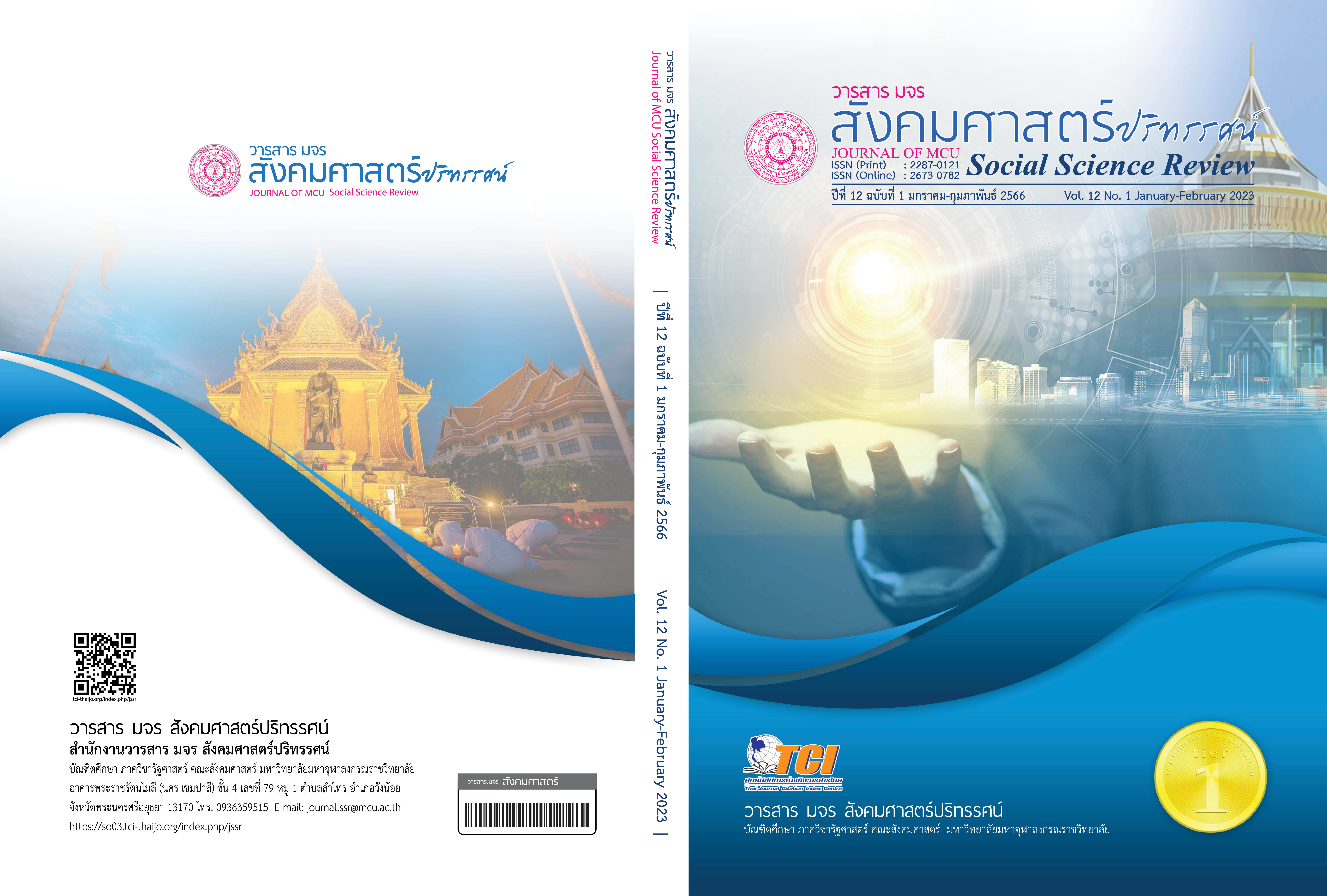การจัดการทรัพยากรมนุษย์ตามแนวพระพุทธศาสนา
คำสำคัญ:
การจัดการ, ทรัพยากรมนุษย์, พุทธวิธีบทคัดย่อ
บทความวิชาการนี้มุ่งนำเสนอพุทธวิธีการจัดการทรัพยากรมนุษย์ (POSDC) คือ พุทธวิธี การวางแผน (P) พุทธวิธีการจัดองค์การ (O) พุทธวิธีการบริหารบุคลากร (S) พุทธวิธีการอำนวยการ (D) และพุทธวิธีการกำกับดูแล (C) ที่พระพุทธองค์ทรงใช้ในการปกครองและบริหารจัดการกิจการคณะสงฆ์ในสมัยพุทธกาล เพื่อนำหลักธรรมคำสอนในทางพระพุทธศาสนา ได้แก่ หลักธรรมสำหรับการสรรหา (Recruitment) คือ ปาปณิกสูตร 3 ประการ หลักธรรมสำหรับการพัฒนา (Development) คือ ไตรสิกขา 3 ประการ และหลักธรรมสำหรับการรักษาพนักงาน (Retention) คือ สังคหวัตถุธรรม ธรรมอันเป็นเครื่องยึดเหนี่ยวจิตใจ 4 ประการ มาเทียบเคียงและประยุกต์ใช้กับการจัดการทรัพยากรมนุษย์ในยุคปัจจุบันที่มุ่งเน้นการสรรหา พัฒนา และรักษาบุคลากรให้มีความรู้ความสามารถมากกว่าคุณธรรมจริยธรรม หากนำหลักธรรมคำสอนในทางพระพุทธศาสนามาประยุกต์ใช้ การจัดการทรัพยากรมนุษย์ก็จะเกิดความสมดุลระหว่างความรู้ ความคิด และจิตสำนึก ทรัพยากรมนุษย์ก็จะเป็นทรัพยากรที่มีศักยภาพทั้งทางร่างกายและจิตใจ ทำให้องค์การมีความเจริญก้าวหน้าได้
เอกสารอ้างอิง
พระธรรมโกศาจารย์ (ประยูร ธมมฺจิตฺโต). (2549). พุทธวิธีในการบริหาร (พิมพ์ครั้งที่ 4). กรุงเทพฯ: โรงพิมพ์มหาจุฬาลงกรณราชวิทยาลัย.
พระพรหมคุณาภรณ์ (ป.อ. ปยุตฺโต). (2559). พจนานุกรมพุทธศาสตร์ ฉบับประมวลธรรม (พิมพ์ครั้งที่ 34). กรุงเทพฯ: มูลนิธิการศึกษาเพื่อสันติภาพ พระธรรมปิฎก (ป.อ. ปยุตฺโต).
พระมหากำพล คุณงฺกโร. (2559). การจัดการทรัพยากรมนุษย์เชิงกลยุทธ์. กรุงเทพฯ: มหาวิทยาลัยมหาจุฬาลงกรณราชวิทยาลัย.
พะยอม วงศ์สารศรี. (2540). การบริหารทรัพยากรมนุษย์ (พิมพ์ครั้งที่ 6). กรุงเทพฯ: คณะวิทยาการจัดการสถาบันราชภัฎสวนดุสิต.
มหาจุฬาลงกรณราชวิทยาลัย. (2539). พระไตรปิฎกภาษาไทย ฉบับมหาจุฬาลงกรณราชวิทยาลัย. กรุงเทพฯ: โรงพิมพ์มหาจุฬาลงกรณราชวิทยาลัย.
ศิริวรรณ เสรีรัตน์. (2550). การจัดการและพฤติกรรมองค์การ. กรุงเทพฯ: ธีระฟิล์ม และไซเท็กซ์ จำกัด.
สมคิด จาตุศรีพิทักษ์. (2544). วิสัยทัศน์ขนคลัง (พิมพ์ครั้งที่ 2). กรุงเทพฯ: ผู้จัดการ.
สมคิด บางโม. (2538). หลักการจัดการ. กรุงเทพฯ : นำอักษรการพิมพ์.
สมเด็จพระพุทธโฆษาจารย์ (ป.อ.ปยุตฺโต). (2564). องค์คุณของอุบาสกอุบาสิกา. สืบค้น 25 ตุลาคม 2564. จาก http://dhamma.SericHon.us/ 2017/01/12/องค์คุณของอุบาสกอุบาสิ/.
สุภาพร พิศาลบุตร และคณะ. (2546). การพัฒนาบุคคลและการฝึกอบรม (พิมพ์ครั้งที่ 4). กรุงเทพฯ: วี.เจ.พริ้นติ้ง.
อำนวย แสงสว่าง. (2540). การจัดการทรัพยากรมนุษย์. กรุงเทพฯ: อักษราพิพัฒน์.
เอ็นพีเอการบัญชี. (2564). พุทธกิจ 5 ประการ. สืบค้น 25 ตุลาคม 2564. จาก https://www. npa- account.com/page.php?name=พุทธกิจ%205%20ประการ.
ดาวน์โหลด
เผยแพร่แล้ว
รูปแบบการอ้างอิง
ฉบับ
ประเภทบทความ
สัญญาอนุญาต
ลิขสิทธิ์ (c) 2023 วารสาร มจร สังคมศาสตร์ปริทรรศน์

อนุญาตภายใต้เงื่อนไข Creative Commons Attribution-NonCommercial-NoDerivatives 4.0 International License.
เพื่อให้เป็นไปตามกฎหมายลิขสิทธิ์ ผู้นิพนธ์ทุกท่านต้องลงลายมือชื่อในแบบฟอร์มใบมอบลิขสิทธิ์บทความให้แก่วารสารฯ พร้อมกับบทความต้นฉบับที่ได้แก้ไขครั้งสุดท้าย นอกจากนี้ ผู้นิพนธ์ทุกท่านต้องยืนยันว่าบทความต้นฉบับที่ส่งมาตีพิมพ์นั้น ได้ส่งมาตีพิมพ์เฉพาะในวารสาร มจร สังคมศาสตร์ปริทรรศน์ เพียงแห่งเดียวเท่านั้น หากมีการใช้ภาพหรือตารางหรือเนื้อหาอื่นๆ ของผู้นิพนธ์อื่นที่ปรากฏในสิ่งตีพิมพ์อื่นมาแล้ว ผู้นิพนธ์ต้องขออนุญาตเจ้าของลิขสิทธิ์ก่อน พร้อมทั้งแสดงหนังสือที่ได้รับการยินยอมต่อบรรณาธิการ ก่อนที่บทความจะได้รับการตีพิมพ์ หากไม่เป็นไปตามข้อกำหนดเบื้องต้น ทางวารสารจะถอดบทความของท่านออกโดยไม่มีข้อยกเว้นใดๆ ทั้งสิ้น





